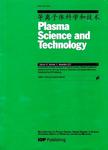Evolution of plasma parameters in an Ar-N2/He inductive plasma source with magnetic pole enhancement
Evolution of plasma parameters in an Ar-N_2/He inductive plasma source with magnetic pole enhancement作者机构:Department of PhysicsPlasma Physics LaboratoryQuaid-i-Azam University45320 IslamabadPakistan Plasma Physics LaboratoryDepartment of PhysicsCOMSATS Institute of Information Technology44000 IslamabadPakistan Department of PhysicsFaculty of ScienceJazan University114 JazanSaudi Arabia
出 版 物:《Plasma Science and Technology》 (等离子体科学和技术(英文版))
年 卷 期:2017年第19卷第2期
页 面:34-42页
核心收录:
学科分类:07[理学] 070204[理学-等离子体物理] 0702[理学-物理学]
基 金:aided by the Higher Education Commission(HEC)under the NRPU Research Project no.2997/R&D/14 COMSATS Institute of Information Technology HEC Research Project no.20-2002(R&D)Quaid-i-Azam University
主 题:MaPE-ICP Langmuir probe OES EEPF
摘 要:Magnetic pole enhanced inductively coupled plasmas (MaPE-ICPs) are a promising source for plasma-based etching and have a wide range of material processing applications. In the present study Langmuir probe and optical emission spectroscopy were used to monitor the evolution of plasma parameters in a MaPE-ICP Ar-Na/He mixture plasma. Electron density (ne) and temperature (Te), excitation temperature (Texc), plasma potential (Vp), skin depth (6) and the evolution of the electron energy probability function (EEPF) are reported as a function of radiofrequency (RF) power, pressure and argon concentration in the mixture. It is observed that ne increases while Te decreases with increase in RF power and argon concentration in the mixture. The emission intensity of the argon line at 750.4 nm is also used to monitor the variation of the ‘high-energy tail' of the EEPF with RF power and gas pressure. The EEPF has a ‘bi-Maxwellian' distribution at low RF powers and higher pressure in a pure N2 discharge. However, it evolves into a ‘Maxwellian' distribution at RF powers greater than 70 W for pure N2, and at 50 W for higher argon concentrations in the mixture. The effect of argon concentration on the temperatures of two electron groups in the ‘bi-Maxwellian' EEPF is examined. The temperature of the low-energy electron group TL shows a decreasing trend with argon addition until the ‘thermalization' of the two temperatures occurs, while the temperature of high-energy electrons Ta decreases continuously.



